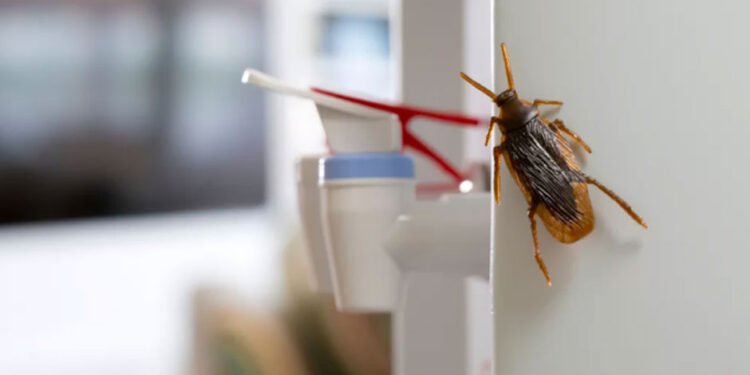Office break rooms might feel like harmless gathering spots, but they’re often ground zero for pest problems. Understanding why these spaces attract bugs and rodents is key to effective pest control for offices, and keeping your workplace clean, healthy, and professional.
Why Office Break Rooms Attract Office Pests
Break rooms combine three things pests crave: food, moisture, and warmth, but what really makes them unique is predictable access. While other areas of an office are quiet and sterile, break rooms are daily feeding zones where crumbs, spills, and trash appear on schedule. The constant foot traffic ensures new scent trails every day, making it easy for ants, cockroaches, and rodents to return to food sources, the perfect storm for any office pest control concern.
Every other space in an office is controlled, desks are wiped, floors are vacuumed, but the break room is where rules bend. It’s the only area designed for eating, socializing, and leaving things out. That small bit of freedom creates unpredictable patterns of residue, smell, and moisture, exactly what pests are wired to seek out. Plus, these spaces often sit near plumbing and HVAC access points, providing easy entry and shelter. To a cockroach, a break room is basically a predictable buffet inside an otherwise sterile desert, which makes it a central focus for office pest management.
Common Office Pests in Break Rooms
The usual suspects are ants, cockroaches, fruit flies, and rodents, but their reasons differ. Ants follow even microscopic food residue, and once a few find sugar or grease, the rest of the colony follows. They’re the office foragers, tracking caffeine spills and sugar grains like a supply chain.
Cockroaches love the hidden warmth behind coffee machines, microwaves, and refrigerators where crumbs collect unseen. They’re the after-hours cleaners, drawn to the heat of appliances and tight spaces that stay undisturbed.
Fruit flies thrive around sugary liquids, forgotten fruit, and residue under coffee machines or in drains, the opportunists of the group. Rodents, meanwhile, find stored snacks and cluttered cabinets ideal for nesting, especially if trash isn’t sealed nightly. If you start noticing droppings or scratching noises, it’s a good idea to call a mice exterminator before the problem spreads beyond the break room. They’re the architects, coming not just for food but for insulation and warmth.
Essentially, break rooms offer everything pests need, food, water, shelter, and predictable human behavior they can exploit. These are the exact conditions that make office pest control and pest control for offices a recurring necessity.
How Food Messes Invite Office Pest Control Issues
Improper food storage doesn’t just feed pests, it trains them. Unsealed snack bags, sugar packets, or unwashed dishes release scent cues that guide pests directly to the source. Even tiny spills under coffee makers or microwaves can sustain an ant trail for days, while leftovers in the fridge past their prime turn into a slow-release buffet for flies and beetles. When food is left exposed, pests learn that the break room is a reliable, recurring resource, and they adapt their nesting patterns around it.
It’s not about one person’s spill, it’s about the accumulation of micro-signals. A few drops of soda, one forgotten apple, a sticky counter, together they build a “chemical map” that pests navigate. Those lingering scent molecules guide ants and roaches to the source like GPS coordinates. In short, pests don’t invade because of food waste, they invade because of patterns. That’s why consistent office pest management is crucial before small messes turn into larger infestations.
Employee Habits That Lead to Office Pests
Human habits are the pest world’s best signal. When employees leave mugs in the sink “for tomorrow” or stash snacks in desks, they create mini feeding stations outside cleaning crews’ reach. Desk drawers with granola bars or candy can attract ants and roaches even without a break-room spill. Over time, this behavior expands the infestation zone from the break room to individual workstations, making the problem harder to isolate or control.
It’s not the occasional mess that causes pests, it’s routine neglect. When food or dishes are left out consistently, pests learn the schedule. Once ants or roaches realize food will reappear in the same drawer or sink daily, they stop foraging and start nesting. A pest infestation is less about one dirty spoon and more about employees unknowingly becoming part of the pest’s daily routine, and that’s when office pest control becomes essential to restore balance.
Moisture and Trash in Office Pest Management
Water is just as critical as food for pest survival. Leaky pipes under sinks, condensation from refrigerators, or clogged drains provide constant hydration sources and create hidden microclimates where roaches and silverfish breed unnoticed. Trash bins that aren’t emptied daily, especially if they sit overnight, become feeding and breeding grounds for flies and cockroaches. Even overfilled recycling bins with sticky soda cans can attract ants and gnats.
Moisture turns a typical office into an ecosystem where pests can survive even when food sources are reduced. To them, an office’s night cycle is their “day.” If you’re not managing conditions after hours, you’re only cleaning for humans, not for pests, and missing a key part of effective pest control for offices.
Early Signs You Need Pest Control for Offices
Ant trails, small piles of debris near baseboards or electrical outlets, or tiny black specks that reappear after cleaning can signal early pest activity. Droppings or grease marks behind appliances, unexplained musty or sweet odors, and tiny gnaw marks on packaging or wires also point to nesting. Fruit flies hovering near drains or trash bins often indicate buildup in unseen pipes, while a lingering sweet or oily smell near microwaves can be a sign of roach pheromones. Even faint buzzing or clicking behind cabinets may reveal movement inside walls.
Spotting these early can prevent a full-blown infestation, which often builds silently behind appliances or wall voids. Early detection isn’t about seeing a pest, it’s about noticing patterns that repeat. Recognizing these clues early allows office pest control experts to intervene before the issue spreads across departments.
Cleaning Tips for Better Office Pest Management
Consistency beats intensity. A single deep clean isn’t enough, pests thrive on routine neglect. A well-structured schedule that includes wiping down surfaces, vacuuming crumbs, sanitizing drains, and checking under appliances prevents small attractants from accumulating. Pair that with periodic inspections near plumbing and HVAC access points, and you cut off the micro-habitats where pests thrive.
A pest-free office doesn’t come from occasional deep cleans but from predictable hygiene. When cleaning happens daily and at roughly the same time, pests lose the ability to feed or nest consistently. The goal isn’t spotless perfection, it’s interruption. Every wiped counter and sealed trash bag breaks the chain of scent and access that pests depend on. Routine isn’t glamorous, but biologically, it’s lethal to pests. Assigning cleaning responsibilities by rotation keeps that consistency alive and ownership shared, and supports long-term office pest management success.
When to Call Office Pest Control Experts
Professionals don’t just eliminate pests, they analyze why they appeared. A trained technician can identify entry points, nesting conditions, and environmental patterns invisible to the untrained eye. The best ones act like detectives, tracking airflow, light exposure, moisture levels, and other conditions that allow pests to survive.
Many commercial pest control providers offer Integrated Pest Management (IPM) programs that focus on prevention through environmental control rather than repeated pesticide use. Instead of spraying and leaving, they work with janitorial teams and management to integrate data-driven schedules and behavioral insights into cleaning protocols. Good office pest control isn’t about killing, it’s about redesigning the environment. That’s how IPM actually works: by changing the ecosystem, not just the population.
Creating a Culture of Office Pest Management
Culture is the best pest deterrent. When employees see cleanliness as part of workplace pride, not a chore, habits shift. Blame doesn’t work, ownership does. When cleanliness becomes part of the company culture, behavior changes naturally.
A few practical ideas: create “clean zone” reminders or subtle visual cues above sinks and microwaves, and make cleaning supplies, wipes, trash liners, dish soap, easily accessible. Rotate weekly break-room champions or leads to oversee end-of-day checks, and offer small incentives or shoutouts for teams that keep spaces spotless. Encourage quick “micro-habits,” like a 60-second wipe rule after using appliances.
Reinforce the idea that a clean break room equals a healthier, more pleasant workplace, not just for humans but as a barrier against pests. When employees see the break room as an extension of the workplace, not a “no one’s problem zone,” pests lose their advantage. A strong office pest management culture supports lasting pest control for offices and keeps every office pest out of sight, and out of mind.












